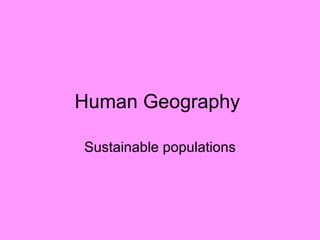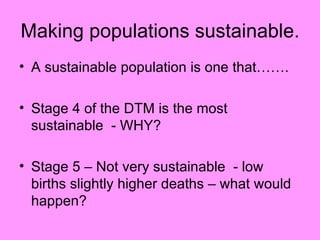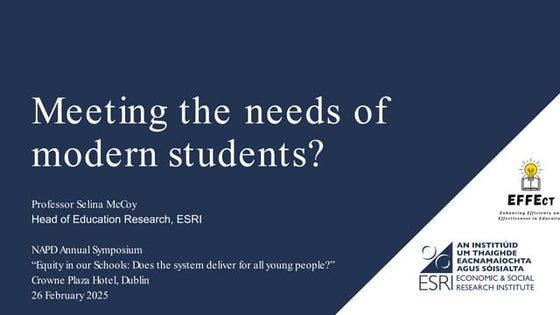Human geography population policies
Download as PPT, PDF1 like928 views
Stage 4 of the demographic transition model is the most sustainable population stage because birth rates are low and death rates are low, leading to a stable population size. Stage 5 is less sustainable as low birth rates coupled with slightly higher death rates could cause the population to decline over time. The document discusses using case studies of China and Kerala, India to analyze population policies and their consequences through adding details to spider diagrams and classroom discussion before practicing exam questions.
1 of 6
Downloaded 11 times






Recommended
5 basic theories of our mind



5 basic theories of our mindPallab Kumar Manna
╠²
What is the reason ofŌĆ”
FAILURE OF MOST OF COMMON SALES PERSON (UNSUCCESSFUL AT PROFESSIONAL LIFE)
MISEARY OF MOST OF COMMON PEOPLE (UNSUCCESSFUL AT THE FAR-MID OR END OF LIFE)
OBJECTIONS PUT BY MOST OF THE COMMON BUYERS (WHILE APPROACHING OR CLOSING SALE)
FAILURE OF MOST OF THE STUDENTS (UNSUCCESSFUL AT STUDY OR EXAM)George and alfie



George and alfieMr Hunt
╠²
We learned about coastal landforms like coastlines and tidal patterns. The course taught us the different types of sea defenses such as groynes, sea walls, and beach reconstruction. For our final project, we had fun making a model showing these various defenses using materials like cardboard and popsicle sticks. The most enjoyable parts of the course were creating the model and meeting new friends.Summer Competition



Summer CompetitionMr Hunt
╠²
The Geography Department at the Appleton School is holding a Geosquishing competition over the summer of 2010. Students are asked to take photographs of famous or infamous locations that they visit on their travels and "GeoSquish" or squeeze the location between their hands. Photographs should be submitted to a geography teacher or emailed to phunt@theappletonschool.org by September 18, 2010. The winner will have their geosquished image printed on a mug.Video Lessons



Video LessonsDavid Deubelbeiss
╠²
This document provides a lengthy list of video-based English language teaching lessons and materials available on the EFL Classroom 2.0 website. It highlights the large library of lessons that use videos and accompanying downloadable materials to make video-integration in the classroom easy. The lessons cover a wide range of topics, genres and skill levels. Paid subscribers to EFL Classroom 2.0 have access to these lessons designed to maximize the potential of using video as an English teaching material.Learning Journeys



Learning Journeyscitizenshipideas
╠²
The document discusses learning journeys, which outline the key activities and objectives that students will complete over a series of lessons to achieve the overall learning goals, and provides guidance on how to effectively plan and communicate learning journeys to improve student motivation, understanding, and independent learning. Examples of learning journeys are presented on various topics ranging from citizenship projects to road safety investigations to illustrate different formats.Nilanont.Animated Story Grammar.MDTESOL.FA2014



Nilanont.Animated Story Grammar.MDTESOL.FA2014Minna Nilanont
╠²
This document discusses using media like cartoons and videos to teach grammar lessons. It provides examples of lessons the author remembered from school involving films and videos. The document also discusses the evolution of media technology over time. It suggests criteria for selecting good video content for language learning and provides an example grammar lesson plan incorporating a video on using different verb tenses.Lorraine Braggins Lipreading assessment 2014



Lorraine Braggins Lipreading assessment 2014Rebecca Eliahoo
╠²
This document describes the development and evaluation of an initial lipreading assessment for adults with acquired deafness attending lipreading classes. Previously, no formal assessment of lipreading skills was conducted. The author outlines arguments against testing but also reasons for developing an assessment, including providing information on students' abilities and identifying those who could fast track.
A 3-part test was devised involving lipreading sentences with and without context clues. 10 students participated and results showed a range of abilities. Feedback indicated the assessment helped students recognize their existing skills without damaging confidence. The author concludes that a brief, sensitively delivered test can provide useful information for teaching while maintaining a relaxed environment. Further evaluation of the test is planned with lipreading instructors.WORKSHOP 1_CURRICULUM MAPPING.docx



WORKSHOP 1_CURRICULUM MAPPING.docxJelynDelaCruzCando
╠²
This document provides a sample curriculum map and assessments for Grade 6 students in an integrative quarter. It includes:
1. Three quarterly assessments testing students on English, Filipino, and MAPEH respectively. The assessments involve creating a video, infomercial, and cartoon character.
2. A scope and sequence chart showing the content areas and standards covered each week, including mini-tasks to meet the performance standards.
3. Details of the assessments, including GRASPS matrices describing the goal, role, audience, scenario and standards for each performance task. An analytic rubric is to be used to evaluate the tasks.
The curriculum map aims to provide an integrated, project-based approach toHuman geography revision dtm



Human geography revision dtmMr Hunt
╠²
The document discusses the demographic transition model (DTM), which describes the stages of change in birth and death rates and population growth of countries. It asks the student to draw and label the DTM, summarize each stage including key features of birth, death, and total population over five minutes. It also provides exam questions asking to describe the use of the DTM and explain what happens at stage 3.Changing urban environments



Changing urban environmentsMr Hunt
╠²
Shanty towns, also known as squatter settlements, have emerged in many large cities in developing countries due to large numbers of people migrating from rural to urban areas. They are characterized by makeshift housing built from scrap materials and lack adequate facilities. Common problems associated with shanty towns include diseases from poor sanitation, hazards from unstable housing, and social and political issues. Some governments have tried relocating residents but with limited success. Improved approaches involve communities in planning and building new housing.Geography gcse year 11 examination preparation booklet



Geography gcse year 11 examination preparation bookletMr Hunt
╠²
The document provides information for students preparing for their Year 11 Geography GCSE examination. It outlines the two sections that will be examined, including topics like population change, migration, urban environments, and tourism. It also includes a glossary defining key terms used in the subject.Rivers fieldwork booklet



Rivers fieldwork bookletMr Hunt
╠²
The document provides information about the processes that shape rivers from their source to mouth, including erosion, transportation, and deposition of materials. Erosion can occur vertically downstream or laterally sideways as a river flows. Transportation involves four methods by which a river moves its load. Deposition happens when the river speed decreases causing it to drop larger materials first, such as when the gradient or velocity decreases or when it meets a lake.Geography gcse mock and examination preparation booklet



Geography gcse mock and examination preparation bookletMr Hunt
╠²
The document provides guidance for students taking a geography GCSE mock exam, outlining the areas and topics that will be covered. It includes sections on plate tectonics, earthquakes, volcanoes, rivers, coastal landforms, and water supply. Students are advised to bring writing implements and a calculator. Key concepts are defined in a glossary. Flash cards summarize key processes, landforms, and management strategies related to various physical geography topics.Exam Level Marking cards



Exam Level Marking cardsMr Hunt
╠²
1) Statements may be in a random order with limited detail and links for 1-4 marks.
2) Statements are linked with some detail, examples, and specialist terms for 5-6 marks.
3) Statements are detailed and interlinked with accurate contextualized information and well-structured sentences for 7-8 marks.Moving stories lesson 8 - Population Pyramids



Moving stories lesson 8 - Population PyramidsMr Hunt
╠²
The document discusses using population pyramids to predict population change. It provides population data for the UK in 2010 and 2050 broken down by age and gender. Population pyramids visually depict this data using bars to show male and female populations in each age group. Comparing pyramids from different times allows predicting how a population will change in the future. The homework is to create a 3D population pyramid for the UK in 2050 using materials like Lego bricks or jelly babies and compare it to the 2010 pyramid.Factors affecting discharge



Factors affecting dischargeMr Hunt
╠²
A flood warning has been issued for riverside properties in Chelmsford, Essex due to heavy overnight rain. Flooding is expected in riverside areas, including the cricket ground and an industrial estate. Residents are advised to protect their property immediately. Some drivers had to be rescued from flooded cars after roads flooded following the heavy rain.Edgar Frost



Edgar FrostMr Hunt
╠²
Eddie Frost was born in 1920 in London and enlisted in the British army in 1940 at age 20. He trained as a glider pilot and took part in Operation Varsity, the largest airborne operation of World War 2 over the Rhine River in Germany in March 1945. During the dangerous landing, Eddie's glider encountered heavy fire and he was killed at just 25 years old. He was buried in the Reichswald Forest War Cemetery in Germany.Ethiopia Goods



Ethiopia GoodsMr Hunt
╠²
A shipment of goods was sent from Ayder High School in Mekelle, Ethiopia. The shipment included jewelry like necklaces and earrings made from local stones in various colors, Ethiopian-style t-shirts with shells on the bottom, women's scarves, wool scarves saying "Love Ethiopia", and children's summer outfits of short-sleeve t-shirts and skirts in various colors. Silver rings were also included.Viewing the World Cup in Uganda



Viewing the World Cup in UgandaMr Hunt
╠²
Mr Docker has been corresponding with Yine Barnabas, who lives in Uganda and went to our link school in Mpigi.
Yine has produced this PowerPoint to show how the World Cup (and EnglandŌĆÖs game against Germany) has been viewed in Uganda. Method Table



Method TableMr Hunt
╠²
This document discusses methods for data collection but provides no details about any specific methods, concepts, descriptions, importance, problems, limitations, or potential developments. It only includes a header for a "Method Linked concept Description" but no corresponding information.Geography Controlled assessment



Geography Controlled assessmentMr Hunt
╠²
The document provides guidance on how to get maximum marks on a geography controlled assessment. It recommends that the introduction should explain the hypothesis being tested, what data will be collected and where, as well as why the theme is important to study. Key terms associated with the theme, such as quarrying and land use, should also be defined. Maps of different scales should be used to locate the study area and show where data will be collected. A method table is then outlined listing the types of data to be collected, such as through questionnaires, surveys, and field sketches, to analyze factors like land use, the environment, and economic benefits.Food miles



Food milesMr Hunt
╠²
This document discusses the origins and food miles of common lunch ingredients like spring onions, tomatoes, bread, radishes, and ham. It finds that while some items like bread and ham came from the UK and traveled 0 km, other items such as spring onions from Egypt and radishes from Israel traveled over 3,500 km each. In total, the ingredients for this typical lunch traveled around 7,464 km, which is the equivalent distance from Benfleet, UK to Brazil.George and paige presentation



George and paige presentationMr Hunt
╠²
This document summarizes a geography course for gifted and talented fifth graders. The students learned about wave formation and different types of waves. They also studied various sea protections like groynes, sea walls, and beach rebuilding. To demonstrate their learning, the students worked as a team to create a 3D model using paper, sticks, and pom-poms to show different sea defenses. They enjoyed making the creative model the most and hope others find their presentation informative.Alice



AliceMr Hunt
╠²
The document summarizes a student's geography course on coastal protection. It details that the student learned how tides and waves are formed, how coastlines are protected, and construction methods and costs for rip rap and groynes. The student made a model demonstrating these concepts using materials like tissue paper, straws, and lolly sticks, and enjoyed making the model and meeting new people in the course.Callum



CallumMr Hunt
╠²
Our model represents how our coastlines are protected from erosion. We first made a base and added crepe paper to represent land and beach. Then we added coastal defences like sea walls, rip rap, and groynes. We layered green paper over hills and included details like a JCB digger. Both Callums enjoyed making the model and being with friends and their teacher on the geography course.Chloe



ChloeMr Hunt
╠²
This document summarizes a student's learning in a gifted and talented geography course. The student learned about coastal landforms like rip rap, groynes, sea walls, and revetments, as well as how waves are formed. They made a model of a beach out of paper and glue showing these landforms. Their favorite part of the course was making the model.Eleanor



EleanorMr Hunt
╠²
This student summarizes what they learned in a geography course for gifted and talented students. They learned about coastal landforms like groynes and rip rap, how waves are formed, and the costs associated with coastal construction projects. To demonstrate their learning, the student created a simple model of a coastal area out of paper, sticks, and straw, showing features like a sea wall, groynes, rip rap, sand, sea, and cliff. They enjoyed making the model and a course video, and conducting outdoor demonstrations of wave formation.Sophia&brooke



Sophia&brookeMr Hunt
╠²
The document summarizes a geography course taken by two gifted students, Sophia and Brooke. They learned about how waves form and coastal protection structures like rip-rap, sea walls, groynes and revetments. To demonstrate, the students made a model out of cardboard and tissue paper showing these features, as well as waves and how beaches are rebuilt. Both students enjoyed learning about coastal erosion and meeting new friends during the course.Entity Framework Interview Questions PDF By ScholarHat



Entity Framework Interview Questions PDF By ScholarHatScholarhat
╠²
Entity Framework Interview Questions PDF By ScholarHatMore Related Content
More from Mr Hunt (20)
Human geography revision dtm



Human geography revision dtmMr Hunt
╠²
The document discusses the demographic transition model (DTM), which describes the stages of change in birth and death rates and population growth of countries. It asks the student to draw and label the DTM, summarize each stage including key features of birth, death, and total population over five minutes. It also provides exam questions asking to describe the use of the DTM and explain what happens at stage 3.Changing urban environments



Changing urban environmentsMr Hunt
╠²
Shanty towns, also known as squatter settlements, have emerged in many large cities in developing countries due to large numbers of people migrating from rural to urban areas. They are characterized by makeshift housing built from scrap materials and lack adequate facilities. Common problems associated with shanty towns include diseases from poor sanitation, hazards from unstable housing, and social and political issues. Some governments have tried relocating residents but with limited success. Improved approaches involve communities in planning and building new housing.Geography gcse year 11 examination preparation booklet



Geography gcse year 11 examination preparation bookletMr Hunt
╠²
The document provides information for students preparing for their Year 11 Geography GCSE examination. It outlines the two sections that will be examined, including topics like population change, migration, urban environments, and tourism. It also includes a glossary defining key terms used in the subject.Rivers fieldwork booklet



Rivers fieldwork bookletMr Hunt
╠²
The document provides information about the processes that shape rivers from their source to mouth, including erosion, transportation, and deposition of materials. Erosion can occur vertically downstream or laterally sideways as a river flows. Transportation involves four methods by which a river moves its load. Deposition happens when the river speed decreases causing it to drop larger materials first, such as when the gradient or velocity decreases or when it meets a lake.Geography gcse mock and examination preparation booklet



Geography gcse mock and examination preparation bookletMr Hunt
╠²
The document provides guidance for students taking a geography GCSE mock exam, outlining the areas and topics that will be covered. It includes sections on plate tectonics, earthquakes, volcanoes, rivers, coastal landforms, and water supply. Students are advised to bring writing implements and a calculator. Key concepts are defined in a glossary. Flash cards summarize key processes, landforms, and management strategies related to various physical geography topics.Exam Level Marking cards



Exam Level Marking cardsMr Hunt
╠²
1) Statements may be in a random order with limited detail and links for 1-4 marks.
2) Statements are linked with some detail, examples, and specialist terms for 5-6 marks.
3) Statements are detailed and interlinked with accurate contextualized information and well-structured sentences for 7-8 marks.Moving stories lesson 8 - Population Pyramids



Moving stories lesson 8 - Population PyramidsMr Hunt
╠²
The document discusses using population pyramids to predict population change. It provides population data for the UK in 2010 and 2050 broken down by age and gender. Population pyramids visually depict this data using bars to show male and female populations in each age group. Comparing pyramids from different times allows predicting how a population will change in the future. The homework is to create a 3D population pyramid for the UK in 2050 using materials like Lego bricks or jelly babies and compare it to the 2010 pyramid.Factors affecting discharge



Factors affecting dischargeMr Hunt
╠²
A flood warning has been issued for riverside properties in Chelmsford, Essex due to heavy overnight rain. Flooding is expected in riverside areas, including the cricket ground and an industrial estate. Residents are advised to protect their property immediately. Some drivers had to be rescued from flooded cars after roads flooded following the heavy rain.Edgar Frost



Edgar FrostMr Hunt
╠²
Eddie Frost was born in 1920 in London and enlisted in the British army in 1940 at age 20. He trained as a glider pilot and took part in Operation Varsity, the largest airborne operation of World War 2 over the Rhine River in Germany in March 1945. During the dangerous landing, Eddie's glider encountered heavy fire and he was killed at just 25 years old. He was buried in the Reichswald Forest War Cemetery in Germany.Ethiopia Goods



Ethiopia GoodsMr Hunt
╠²
A shipment of goods was sent from Ayder High School in Mekelle, Ethiopia. The shipment included jewelry like necklaces and earrings made from local stones in various colors, Ethiopian-style t-shirts with shells on the bottom, women's scarves, wool scarves saying "Love Ethiopia", and children's summer outfits of short-sleeve t-shirts and skirts in various colors. Silver rings were also included.Viewing the World Cup in Uganda



Viewing the World Cup in UgandaMr Hunt
╠²
Mr Docker has been corresponding with Yine Barnabas, who lives in Uganda and went to our link school in Mpigi.
Yine has produced this PowerPoint to show how the World Cup (and EnglandŌĆÖs game against Germany) has been viewed in Uganda. Method Table



Method TableMr Hunt
╠²
This document discusses methods for data collection but provides no details about any specific methods, concepts, descriptions, importance, problems, limitations, or potential developments. It only includes a header for a "Method Linked concept Description" but no corresponding information.Geography Controlled assessment



Geography Controlled assessmentMr Hunt
╠²
The document provides guidance on how to get maximum marks on a geography controlled assessment. It recommends that the introduction should explain the hypothesis being tested, what data will be collected and where, as well as why the theme is important to study. Key terms associated with the theme, such as quarrying and land use, should also be defined. Maps of different scales should be used to locate the study area and show where data will be collected. A method table is then outlined listing the types of data to be collected, such as through questionnaires, surveys, and field sketches, to analyze factors like land use, the environment, and economic benefits.Food miles



Food milesMr Hunt
╠²
This document discusses the origins and food miles of common lunch ingredients like spring onions, tomatoes, bread, radishes, and ham. It finds that while some items like bread and ham came from the UK and traveled 0 km, other items such as spring onions from Egypt and radishes from Israel traveled over 3,500 km each. In total, the ingredients for this typical lunch traveled around 7,464 km, which is the equivalent distance from Benfleet, UK to Brazil.George and paige presentation



George and paige presentationMr Hunt
╠²
This document summarizes a geography course for gifted and talented fifth graders. The students learned about wave formation and different types of waves. They also studied various sea protections like groynes, sea walls, and beach rebuilding. To demonstrate their learning, the students worked as a team to create a 3D model using paper, sticks, and pom-poms to show different sea defenses. They enjoyed making the creative model the most and hope others find their presentation informative.Alice



AliceMr Hunt
╠²
The document summarizes a student's geography course on coastal protection. It details that the student learned how tides and waves are formed, how coastlines are protected, and construction methods and costs for rip rap and groynes. The student made a model demonstrating these concepts using materials like tissue paper, straws, and lolly sticks, and enjoyed making the model and meeting new people in the course.Callum



CallumMr Hunt
╠²
Our model represents how our coastlines are protected from erosion. We first made a base and added crepe paper to represent land and beach. Then we added coastal defences like sea walls, rip rap, and groynes. We layered green paper over hills and included details like a JCB digger. Both Callums enjoyed making the model and being with friends and their teacher on the geography course.Chloe



ChloeMr Hunt
╠²
This document summarizes a student's learning in a gifted and talented geography course. The student learned about coastal landforms like rip rap, groynes, sea walls, and revetments, as well as how waves are formed. They made a model of a beach out of paper and glue showing these landforms. Their favorite part of the course was making the model.Eleanor



EleanorMr Hunt
╠²
This student summarizes what they learned in a geography course for gifted and talented students. They learned about coastal landforms like groynes and rip rap, how waves are formed, and the costs associated with coastal construction projects. To demonstrate their learning, the student created a simple model of a coastal area out of paper, sticks, and straw, showing features like a sea wall, groynes, rip rap, sand, sea, and cliff. They enjoyed making the model and a course video, and conducting outdoor demonstrations of wave formation.Sophia&brooke



Sophia&brookeMr Hunt
╠²
The document summarizes a geography course taken by two gifted students, Sophia and Brooke. They learned about how waves form and coastal protection structures like rip-rap, sea walls, groynes and revetments. To demonstrate, the students made a model out of cardboard and tissue paper showing these features, as well as waves and how beaches are rebuilt. Both students enjoyed learning about coastal erosion and meeting new friends during the course.Recently uploaded (20)
Entity Framework Interview Questions PDF By ScholarHat



Entity Framework Interview Questions PDF By ScholarHatScholarhat
╠²
Entity Framework Interview Questions PDF By ScholarHatChapter 2. Strategic Management: Corporate Governance.pdf



Chapter 2. Strategic Management: Corporate Governance.pdfRommel Regala
╠²
This course provides students with a comprehensive understanding of strategic management principles, frameworks, and applications in business. It explores strategic planning, environmental analysis, corporate governance, business ethics, and sustainability. The course integrates Sustainable Development Goals (SDGs) to enhance global and ethical perspectives in decision-making.Interim Guidelines for PMES-DM-17-2025-PPT.pptx



Interim Guidelines for PMES-DM-17-2025-PPT.pptxsirjeromemanansala
╠²
This is the latest issuance on PMES as replacement of RPMS. Kindly message me to gain full access of the presentation. RRB ALP CBT 2 RAC Question Paper MCQ (Railway Assistant Loco Pilot)



RRB ALP CBT 2 RAC Question Paper MCQ (Railway Assistant Loco Pilot)SONU HEETSON
╠²
RRB ALP CBT 2 RAC Question Paper MCQ PDF Free Download. Railway Assistant Loco Pilot Mechanic Refrigeration and Air Conditioning Important Questions.Meeting the needs of modern students?, Selina McCoy



Meeting the needs of modern students?, Selina McCoyEconomic and Social Research Institute
╠²
NAPD Annual Symposium
ŌĆ£Equity in our Schools: Does the system deliver for all young people?ŌĆØEffective Product Variant Management in Odoo 18



Effective Product Variant Management in Odoo 18Celine George
╠²
In this slide weŌĆÖll discuss on the effective product variant management in Odoo 18. Odoo concentrates on managing product variations and offers a distinct area for doing so. Product variants provide unique characteristics like size and color to single products, which can be managed at the product template level for all attributes and variants or at the variant level for individual variants.Inventory Reporting in Odoo 17 - Odoo 17 Inventory App



Inventory Reporting in Odoo 17 - Odoo 17 Inventory AppCeline George
╠²
This slide will helps us to efficiently create detailed reports of different records defined in its modules, both analytical and quantitative, with Odoo 17 ERP.Year 10 The Senior Phase Session 3 Term 1.pptx



Year 10 The Senior Phase Session 3 Term 1.pptxmansk2
╠²
Year 10 The Senior Phase Session 3 Term 1.pptxMastering Soft Tissue Therapy & Sports Taping



Mastering Soft Tissue Therapy & Sports TapingKusal Goonewardena
╠²
Mastering Soft Tissue Therapy & Sports Taping: Pathway to Sports Medicine Excellence
This presentation was delivered in Colombo, Sri Lanka, at the Institute of Sports Medicine to an audience of sports physiotherapists, exercise scientists, athletic trainers, and healthcare professionals. Led by Kusal Goonewardena (PhD Candidate - Muscle Fatigue, APA Titled Sports & Exercise Physiotherapist) and Gayath Jayasinghe (Sports Scientist), the session provided comprehensive training on soft tissue assessment, treatment techniques, and essential sports taping methods.
Key topics covered:
Ō£ģ Soft Tissue Therapy ŌĆō The science behind muscle, fascia, and joint assessment for optimal treatment outcomes.
Ō£ģ Sports Taping Techniques ŌĆō Practical applications for injury prevention and rehabilitation, including ankle, knee, shoulder, thoracic, and cervical spine taping.
Ō£ģ Sports Trainer Level 1 Course by Sports Medicine Australia ŌĆō A gateway to professional development, career opportunities, and working in Australia.
This training mirrors the Elite Akademy Sports Medicine standards, ensuring evidence-based approaches to injury management and athlete care.
If you are a sports professional looking to enhance your clinical skills and open doors to global opportunities, this presentation is for you.Bß╗ś TEST KIß╗éM TRA GIß╗«A K├ī 2 - TIß║ŠNG ANH 10,11,12 - CHUß║©N FORM 2025 - GLOBAL SU...



Bß╗ś TEST KIß╗éM TRA GIß╗«A K├ī 2 - TIß║ŠNG ANH 10,11,12 - CHUß║©N FORM 2025 - GLOBAL SU...Nguyen Thanh Tu Collection
╠²
https://app.box.com/s/ij1ty3vm7el9i4qfrr41o756xycbahmgASP.NET Web API Interview Questions By Scholarhat



ASP.NET Web API Interview Questions By ScholarhatScholarhat
╠²
ASP.NET Web API Interview Questions By ScholarhatDr. Ansari Khurshid Ahmed- Factors affecting Validity of a Test.pptx



Dr. Ansari Khurshid Ahmed- Factors affecting Validity of a Test.pptxKhurshid Ahmed Ansari
╠²
Validity is an important characteristic of a test. A test having low validity is of little use. Validity is the accuracy with which a test measures whatever it is supposed to measure. Validity can be low, moderate or high. There are many factors which affect the validity of a test. If these factors are controlled, then the validity of the test can be maintained to a high level. In the power point presentation, factors affecting validity are discussed with the help of concrete examples.AI and Academic Writing, Short Term Course in Academic Writing and Publicatio...



AI and Academic Writing, Short Term Course in Academic Writing and Publicatio...Prof. (Dr.) Vinod Kumar Kanvaria
╠²
AI and Academic Writing, Short Term Course in Academic Writing and Publication, UGC-MMTTC, MANUU, 25/02/2025, Prof. (Dr.) Vinod Kumar Kanvaria, University of Delhi, vinodpr111@gmail.comBß╗ś TEST KIß╗éM TRA GIß╗«A K├ī 2 - TIß║ŠNG ANH 10,11,12 - CHUß║©N FORM 2025 - GLOBAL SU...



Bß╗ś TEST KIß╗éM TRA GIß╗«A K├ī 2 - TIß║ŠNG ANH 10,11,12 - CHUß║©N FORM 2025 - GLOBAL SU...Nguyen Thanh Tu Collection
╠²
AI and Academic Writing, Short Term Course in Academic Writing and Publicatio...



AI and Academic Writing, Short Term Course in Academic Writing and Publicatio...Prof. (Dr.) Vinod Kumar Kanvaria
╠²
Human geography population policies
- 1. Human Geography Sustainable populations
- 2. Starter - Recap population pyramids http://www.tubechop.com/watch/159460 http://www.tubechop.com/watch/159463
- 3. Making populations sustainable. A sustainable population is one thatŌĆ”ŌĆ”. Stage 4 of the DTM is the most sustainable - WHY? Stage 5 ŌĆō Not very sustainable - low births slightly higher deaths ŌĆō what would happen?
- 4. Case Study 1. China Silent debate! No talking Move around the classroom Add ideas to the Spider diagrams Now watch the Video - Video 2 ŌĆō add more details to the diagrams
- 5. Case Study 2 ŌĆō Kerala - India Silent debate! No talking Move around the classroom Add ideas to the Spider diagrams Now watch the Video 1 Video ŌĆō add more details to the diagrams
- 6. Exam practice Level 3 Answer. Work in pairs to plan answer.. Explain, with reference to a case study, the consequences of a population policy. 8 Marks ŌĆō 10 Minutes PLAN FACTS ŌĆō DETAIL WRITE






